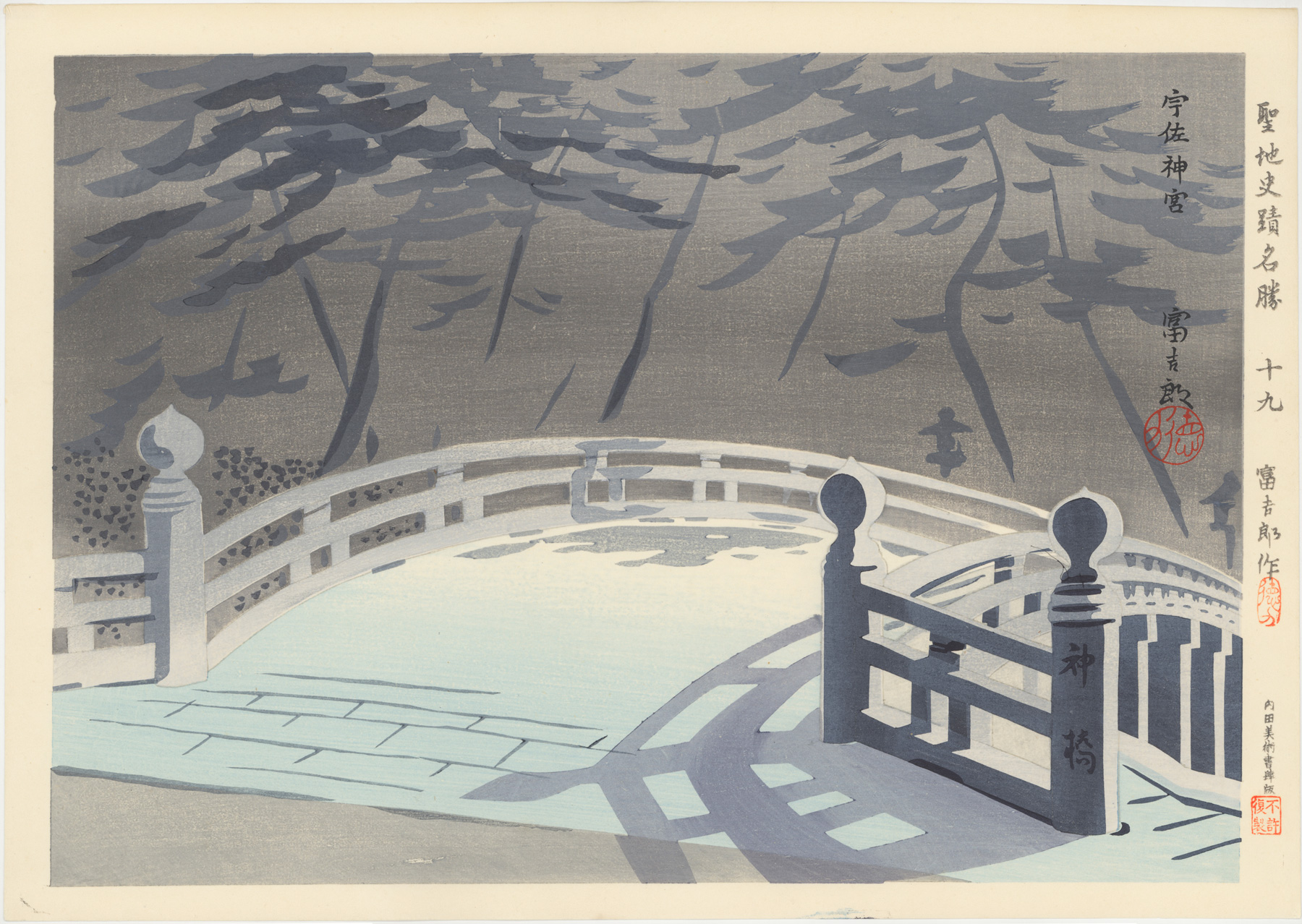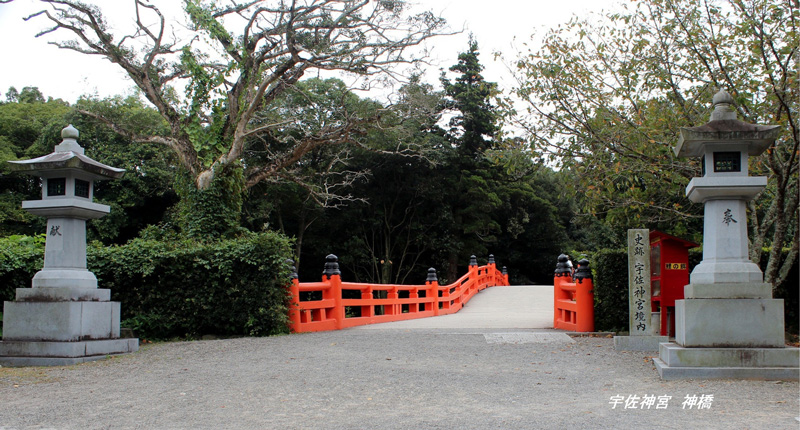About This Print
Print number nineteen in the fifty print series Scenes of Sacred and Historic Places (Seichi Shiseki Meisho) published by Uchida Woodblock Printing Company in 1941. Tokuriki gives us a view of the sacred bridge[神橋 shinkyō] at the shrine on a moonlit evening. The bridge leads to the main entrance of the shrine.
The Series - Scenes of Sacred and Historic Places
The print artist Tokuriki and the publisher Unsōdō created two series of prints to mark Kigen 2600, or the 2600th year of Japan's mythical founding as a nation. The first, a paean to Mount Fuji, a sacred site of pilgrimage and worship, titled Thirty-Six Views of Mount Fuji, harkened back to Hokusai’s famous 1831 series of the same name. The second series, Scenes of Sacred and Historic Places, capitalized on the nationalist ideology that Japan was a divine land, presenting overtly nationalistic landscapes including shrines, temples, castles, places associated with the divine origins of Japan, Meiji era history and samurai
Margin Annotations of Original Edition (top to bottom) and Print Title Within Image
1 possibly a reproduction of an old censor's seal
The title of each print appears within the image area along with the artist's signature and seal. The artist's signature is comprised of the artist's name 富吉郎 (Tomikichirō) either by itself or followed by the single kanji character 作 (saku "made by") or by the character 謹 (kin "respectfully") followed by 作, as shown below.

Usa Shrine
Source: Wikipedia https://en.wikipedia.org/wiki/Usa_Jing%C5%AB;
The shrine was founded in Kyūshū during the Nara period. Ancient records place the foundation of Usa jingū in the Wadō era (708-714). A temple called Miroku-ji was built next to it in 779, making it what is believed to be the first shrine-temple (jingū-ji) ever. From 1871 through 1946, Usa was officially designated one of the Kanpei-taisha (官幣大社), meaning that it stood in the first rank of government supported shrines.
Usa jingu Shrine is the main sanctum of over 40,000 hachiman shrine locations throughout the nation.
There are many shrines in Japan which are named Hachiman-gu. The Emperor Ojin, who was deified as Hachiman-shin (the god of military power), is enshrined in these shrines. Usa-jingu was the first of these shrines. It is said that Hachiman-shin appeared at this place around the beginning of the 8th century. He was widely worshiped throughout Kyūshū, and was subsequently worshiped as the protective deity of the Imperial Capital.
The shrine has enjoyed the close protection of the Imperial Family. The present sanctuary, which is designated as a National Treasure, was built around the middle of the 19th century.
The sacred bridge leading to the shrine
The Series - Scenes of Sacred and Historic Places
The print artist Tokuriki and the publisher Unsōdō created two series of prints to mark Kigen 2600, or the 2600th year of Japan's mythical founding as a nation. The first, a paean to Mount Fuji, a sacred site of pilgrimage and worship, titled Thirty-Six Views of Mount Fuji, harkened back to Hokusai’s famous 1831 series of the same name. The second series, Scenes of Sacred and Historic Places, capitalized on the nationalist ideology that Japan was a divine land, presenting overtly nationalistic landscapes including shrines, temples, castles, places associated with the divine origins of Japan, Meiji era history and samurai
culture.
In his commentary on this series, the artist wrote that his devotion to these sites is intended to demonstrate to the people the dignity of the national polity, going on to say that he advocates prints as a means of providing comfort and pleasure to the wholesome citizens of the nation.
This series was extremely popular with domestic and foreign buyers who purchased one thousand copies within a short time after issuance.1 I imagine that foreign buyers were enchanted by the lovely scenes with much of the import of each print escaping them. In the 1950s, six prints from this series were re-printed under the title The Album of Famous Views of Japan and eight additional prints were re-printed under the title The Eight Views of Japan. Later printings omit the information in the margin and some position the artist's signature and print title within the image in a different location from the original issue.
For images of all the prints in the series, go to the website of Ross Walker's Ohmi Gallery at http://www.ohmigallery.com/Gallery/Tokuriki/SacredPlaces.htm.
1 Modern Japanese Woodblock Prints - The Early Years, Helen Merritt, University of Hawaii Press, 1998, p. 89.
In his commentary on this series, the artist wrote that his devotion to these sites is intended to demonstrate to the people the dignity of the national polity, going on to say that he advocates prints as a means of providing comfort and pleasure to the wholesome citizens of the nation.
For images of all the prints in the series, go to the website of Ross Walker's Ohmi Gallery at http://www.ohmigallery.com/Gallery/Tokuriki/SacredPlaces.htm.
1 Modern Japanese Woodblock Prints - The Early Years, Helen Merritt, University of Hawaii Press, 1998, p. 89.
Margin Annotations of Original Edition (top to bottom) and Print Title Within Image
 series title Seichi Shiseki Meisho 聖地 史蹟 名勝 |  十九 (19) |  Tomikichiro kin saku 富吉郎 謹作 (respectfully made by Tomikichiro) followed by oval seal1 |  内田美術書肆版 (Uchida Fine Art Shop) followed in seal form by Fukyo Fukusei (Reproduction forbidden)) | Print Title  宇佐神宮 [Usa Jingū] |
1 possibly a reproduction of an old censor's seal
The title of each print appears within the image area along with the artist's signature and seal. The artist's signature is comprised of the artist's name 富吉郎 (Tomikichirō) either by itself or followed by the single kanji character 作 (saku "made by") or by the character 謹 (kin "respectfully") followed by 作, as shown below.

| IHL Catalog | #1651 |
| Title | Usa Shrine 宇佐神宮 [Usa Jingū] |
| Series | Scenes of Sacred and Historic Places (also seen translated as "Collected Prints of Sacred, Historic and Scenic Places") 聖地 史蹟 名勝 Seichi Shiseki Meisho |
| Artist | Tokuriki Tomikichirō (1902-2000) |
| Signature |  |
| Seal | 徳力 Tokuriki seal (see detail above) |
| Date | September 1941 |
| Edition | original (first) edition |
| Publisher | Uchida Bijutsu Shoten |
| Impression | excellent |
| Colors | excellent |
| Condition | excellent - minor mounting residue top corners verso from previous folio mounting |
| Genre | shin hanga (new print); fūkeiga |
| Miscellaneous | 十九 #19 in series |
| Format | horizontal ōban |
| H x W Paper | 11 7/16 x 16 1/4 in. (29.1 x 41.3 cm) |
| H x W Image | 10 3/8 x 14 15/16 (26.4 x 37.9 cm) |
| Collections This Print | Penn Libraries, Rare Book & Manuscript Library - Rare Book Collection Call no.: Portfolio NE1325.T65 A4 1940 |
| Reference Literature |



